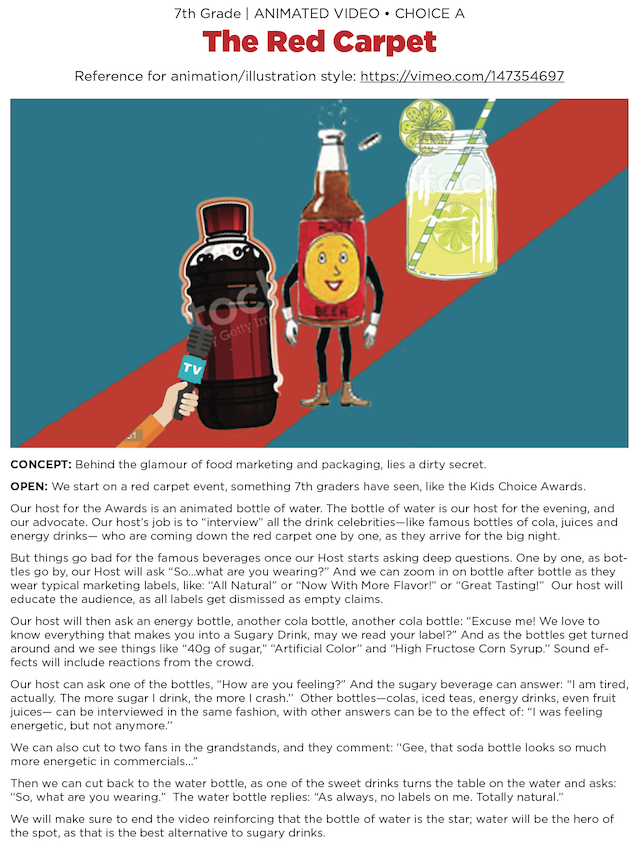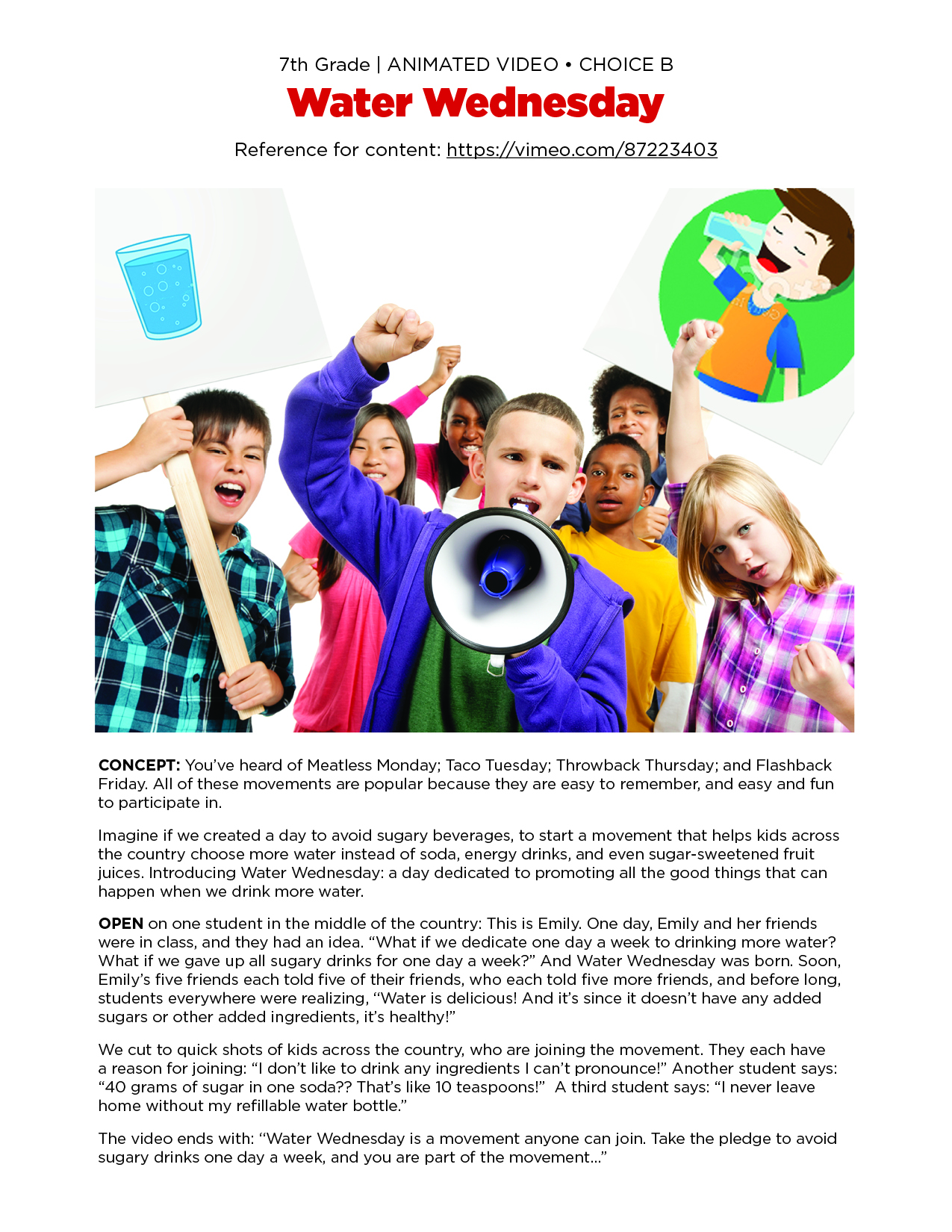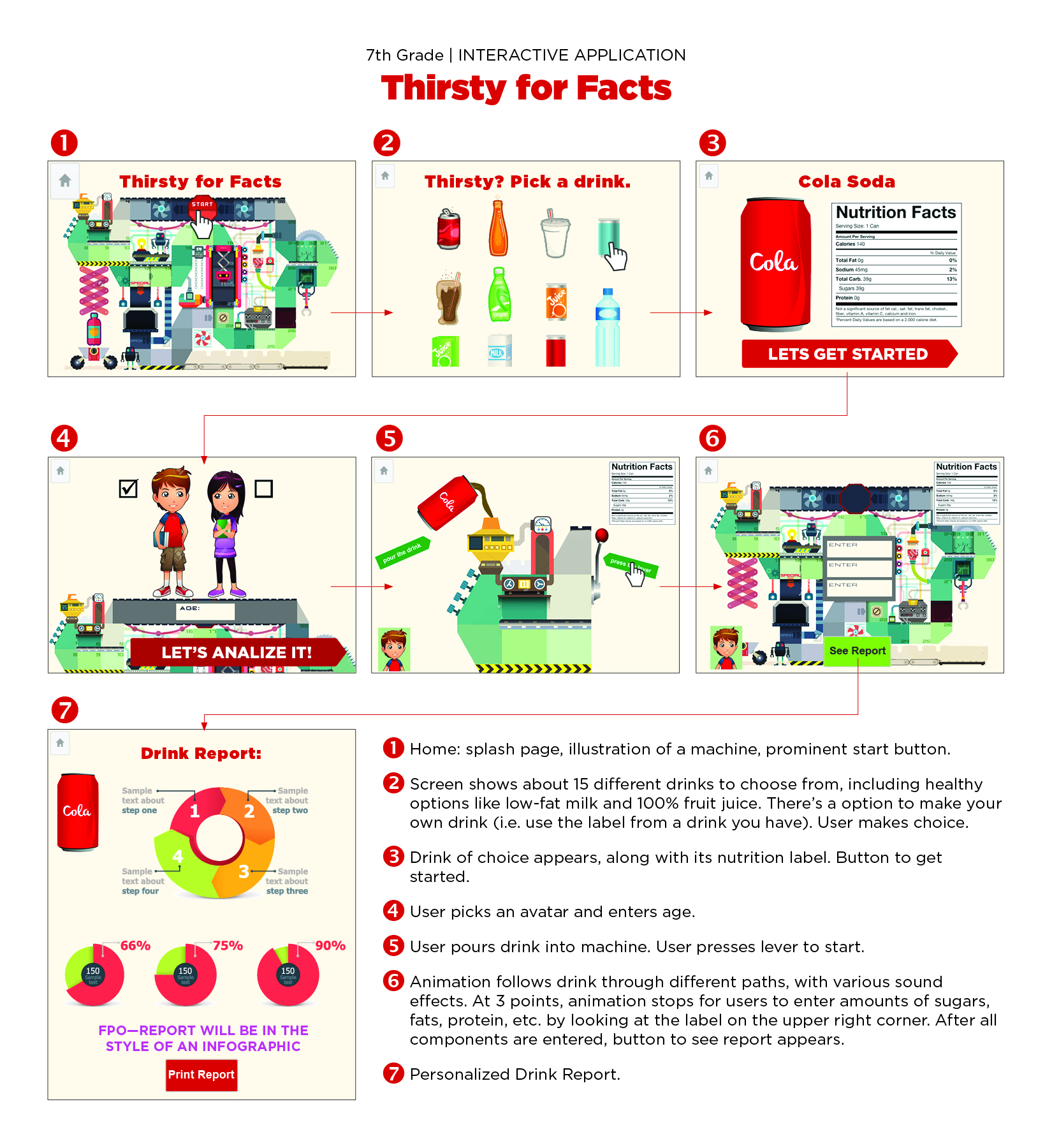Middle School Digital Nutrition I/H
Generic Clearance to Conduct Formative Research
Attachment N_Focus Group Stimulus_Grade 7-rev
Middle School Digital Nutrition I/H
OMB: 0584-0524
OMB Control Number: 0584-0524 | Expires 06/30/2016
Attachment N
OMB BURDEN STATEMENT: According to the Paperwork Reduction Act of 1995, no persons are required to respond to a collection of information unless it displays a valid OMB control number. The valid OMB control number for this information collection is 0584-0524. The time to complete this information collection is estimated at 15 minutes, including the time for reviewing instructions and completing the information collection.
7th GRADE: “The HISTORY About Food”
Key Message: Choose Water Instead of Sugary Drinks
Secondary Message: General Dietary Guidelines Information
7th Grade | INFORMATIONAL TEXT ARTICLES
Understanding the 2015 Dietary Guidelines
Added Sugars and Your Health
Possible Question Stems
Based on 7th Grade Common Core Standards:
Explicit Information (Reading Literature (RL) 7.1, Reading for Information (RI) 7.1):
Which of the following inferences can be drawn from these two quotes...? (or from lines (xx) and lines (xx)...?
Why do you believe (evaluate)...? and choose two quotes from the text as evidence.
Theme / Idea (RL 7.2, RI 7.2)
What was the author’s main point in paragraph x...?
Which of the following quotes from the passage is evidence of the central theme?
Word Use (RL 7.4, RI 7.4)
What does the word/phrase _____ mean in this selection? (i.e. What does the phrase added sugars mean?)
Which of the following synonyms is closest to the meaning of the word _____ in line x...? (i.e. What is the difference between sugars and added sugars?)
Purpose (RL 7.6, RI 7.6)
What is the author’s point of view or purpose...?
Which of the following are opposing this author's point of view...?
Based on the author’s information, what is your opinion on...?
Arguments / Claims (RI 7.8)
Which of the following claims are not supported by the text...?
Which of the following evidence supporting the argument is most relevant...?
Article 1: Understanding the 2015 Dietary Guidelines
This informational text article will explain the 2015 Dietary Guidelines and connect to the subject area of History by exploring the history behind the creation of the guidelines.
Educational topics covered:
The earliest version of the Dietary Guidelines - then known as Dietary Goals - was released in 1977 by the U.S. Senate Select Committee on Nutrition and Human Needs.
The Dietary Guidelines are released by the U.S. Department of Health and Human Services (HHS) and the U.S. Department of Agriculture (USDA) every 5 years.
The Dietary Guidelines are used by health professionals, nutrition education programs, and policy makers. MyPlate is based on the DGA and was developed to help consumers identify healthy eating patterns.
While many of the recommendations in the Dietary Guidelines have remained consistent, they have also evolved in response to new scientific understandings and public health issues such as chronic dietary disease.
Specific recommendations of the 2015 Dietary Guidelines include:
Follow a healthy eating pattern. Everything you eat and drink over time matters. The right mix can help you be healthier now and in the future.
Make half your grains whole grains.
Drink and eat less sodium, saturated fat, and added sugars.
Drink water instead of sugary drinks.
Follow MyPlate: choose foods and beverages from each food group.
Subject area tie-in: History
The history of the Dietary Guidelines
The 2015-2020 Dietary Guidelines
Article 2: Added Sugars and Your Health
This informational text article will help students understand that sugar is added to many common foods and beverages, and will connect to the subject area of History by exploring the history of sugary sports drinks, colas, and serving sizes.
Educational topics covered:
Sugar is added to many foods and beverages we eat and drink every day.
Eating and drinking too much added sugar may lead to cavities. And the extra calories may make it hard to keep a healthy weight.
Foods and drinks with lots of added sugar replace nutrients that you need to grow strong.
Sugary beverages, like cola and sports drinks, are a major source of added sugars.
We should limit our intake of added sugars to 10% of calories each day.
A single can of cola often contains 10 teaspoons of added sugar, which is 40 grams of sugar. That’s 8% of your daily calories in one drink!
Drinking water instead of sugary drinks is a smart way to avoid added sugars.
Sports drinks were originally created to help athletes replace nutrients lost through sweating, and are now consumed as part of daily lifestyles.
Serving sizes have increased over time. 20 years ago, the standard soda size was 6.5 ounces and contained 85 calorie. Today, the standard soda size is 20 ounces and contains 250 calories.
Subject area tie-in: History
The history of sports drinks and colas, and serving sizes
Messages
Key: Choose water instead of sugary drinks
Secondary: Dietary Guidelines Information and the 2015 version
Lesson Outline
Transfer Objective
Students will be able to independently use their learning from these activities to:
Increasingly choose water over sugary beverages.
Learning Objectives
Students will be able to:
Identify how much added sugar they should consume each day.
Evaluate messages and marketing graphics on beverage labels.
Communicate the benefits of drinking water.
Understand and explain sugar’s impact on our body, including oral health.
Enduring Understandings
Water is the best beverage choice because it has zero calories or sugar, it is readily available, and is often free.
Food and beverage manufacturers use marketing and design to sell their product. Reading the nutrition label and being conscious of claims meant to persuade you can help you make better choices.
Drinking beverages with added sugar can lead to health problems (When sugars are added to foods and beverages to sweeten them, they add calories without contributing essential nutrients and, therefore, may contribute to excess calorie intake without contributing to diet quality. This may lead to risk of obesity, type 2 diabetes, and some types of cancer in adults).
Essential Questions
How have beverages changed over time?
How has beverage consumption changed over time?
What influences my beverage choices?
Why does what I drink matter?
Activities
Read “Dietary Guidelines” and “Added Sugars and Your Health” informational text articles
Answer comprehension questions
Participate in class discussion
Analyze different beverage labels (handout to be created)
View and analyze Nutrition Facts panel.
View and analyze a picture of the front of a bottle. Identify promoted and hidden messages and the marketing designs or features.
Research and report the benefits of drinking water. Identify challenges and ways to overcome them.
Track sugar consumption
Use SuperTracker or a simpler handout to track individual sugar consumption during one day.
Analyze the biggest sources of added sugar and propose ways to reduce consumption.
Water Wednesday Celebrations
Challenge the school community to replace as many sugary beverages as they can with water every Wednesday.
Celebrate water by sharing fun water facts through posters or PA system announcements.
Standards
Science - Water and Our Bodies
History/Social Studies - History of Beverage Industry and Government Interventions
Challenge and Investigation (handout to be created)
Students will choose one of their favorite beverages to investigate. They will use the interactive application to enter information and learn more about the contents of their beverage. After recording information about their data, they will examine the front of the bottle to identify promotional messaging, marketing designs or slogans, and messages about the beverage’s contents that are not advertised. On the handout, they will sketch a new label for their beverage with new messages and/or designs for the front of the bottle that more accurately represent what is inside.
Interactive Application Tie-in
The interactive application will be used as part of the investigation activity following the lesson activities, by analyzing beverage labels.
Video Tie-in
This video will help introduce the challenge and investigation, by communicating the importance of understanding what’s inside a beverage and why students should choose water instead of sugary drinks. Kids will learn to differentiate the distracting marketing claims from real nutrition information.


S tudents
will learn about the importance of choosing water instead of sugary
drinks by using an Interactive Calculator. Students will “pour”
a drink into an Analyzer, and then enter several pieces of
information from the nutritional label into a calculator (i.e., grams
of sugar, calories, calories from sugar, serving size, number of
servings, etc.). The result will be a personalized graphic with data
points (i.e., total amount of added sugar, health information), that
they can print out and aim to improve upon.
tudents
will learn about the importance of choosing water instead of sugary
drinks by using an Interactive Calculator. Students will “pour”
a drink into an Analyzer, and then enter several pieces of
information from the nutritional label into a calculator (i.e., grams
of sugar, calories, calories from sugar, serving size, number of
servings, etc.). The result will be a personalized graphic with data
points (i.e., total amount of added sugar, health information), that
they can print out and aim to improve upon.
| File Type | application/vnd.openxmlformats-officedocument.wordprocessingml.document |
| Author | Carla Berger |
| File Modified | 0000-00-00 |
| File Created | 2021-01-23 |
© 2025 OMB.report | Privacy Policy